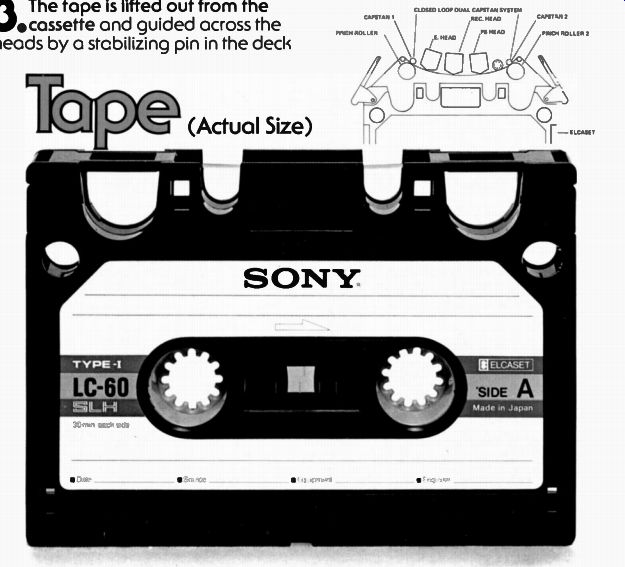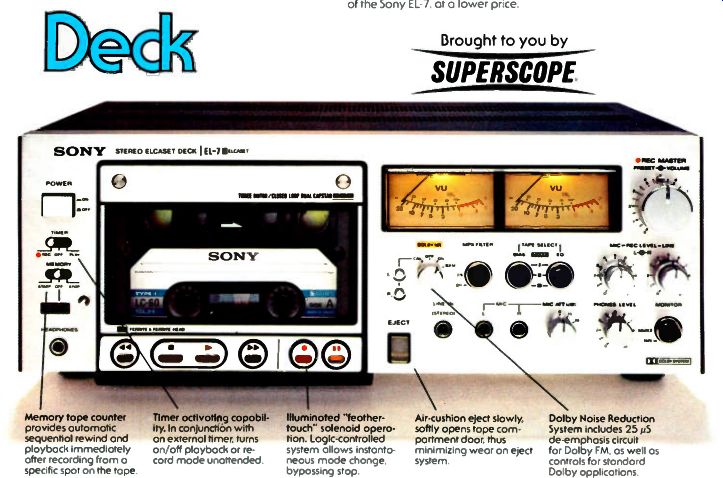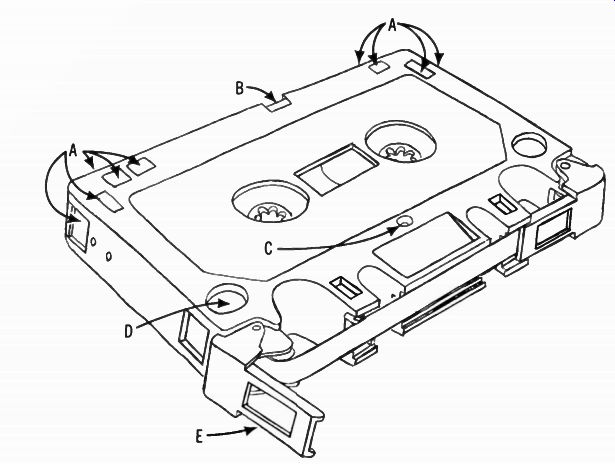Assessing the future of the newest tape format.
by Larry Zide

IT is 1977, and the folklore that forecasts the introduction of a new tape format every few years has once again been fulfilled. Rumors had begun to sprout as early as late 1975, and by mid-1976 there was little doubt about what was to come. It was, of course, the Elcaset.
What is an Elcaset? To the eye, it’s simply a large cassette, and its very name reflects that fact-- "El" (L) for large, plus a simplified spelling of "cassette." The volume of its casing is such that it would hold just about four standard cassettes.
Like a standard ("compact") cassette, the Elcaset plays or records in a transport designed for it. But beyond that, most things are different. For one, the tape travels at 3 3/4 inches per second, twice the speed of the cassette's tape. For another, the tape is a full quarter-inch wide, approximately twice as wide as that for cassettes. Further, the tape is pulled out from the front by the transport to con tact the heads and drive mechanism and then re turned to the shell. Thus the transport, and not the shell, becomes the arbiter of how precisely the tape moves and contacts the heads-much as with open-reel tape.
Like the compact cassette, the Elcaset is a four track record/play format. Two tracks make a stereo pair, and four tracks conceivably can be used to create quad. But the Elcaset has two additional narrow tracks down the center of the tape (between the stereo pairs of audio tracks), where cueing information can be recorded. This gives the Elcaset a potential versatility comparable to that Larry Zide, an audio writer based in New York, makes his own tapes for his weekly radio show Adventures in Sound for station WQXR. of ADC's new Accutrac record-playing equipment.
An old saw--and a valid one--in tape recording states: Anything you can do at one tape speed, I can do better at twice that speed. First, at double the speed the signal-to-noise ratio improves by some 3 dB. And the higher speed allows high-frequency response with less recording equalization, which in turn means less distortion. Also, since the recorded wavelengths are longer, there is less potential problem with self-erasure at high frequency. Being twice as wide as a regular cassette, the Elcaset gains another 3 dB or so in S/N ratio, which makes it a total of about 6 dB quieter. So it would seem to have a lot going for it.

Yet the new format remains controversial within the audio industry. To find out what the brouhaha is all about requires a long careful look at the compact cassette. From its humble beginnings in dictating machines just a decade ago, the cassette has grown to the stature of a true high fidelity product-this we can agree on. But just how good is a cassette? How good can it be? The answer depends on what you want from the tape medium. If you want to copy precious discs or record valuable broadcasts, you can hardly surpass the regular cassette. There are numerous cassette recorders that can make such copies altogether indistinguishable from the original. The bandwidth and dynamic range of the cassette medium is about as good as (and often better than) that of the source material, so using a more capable format would yield little or no benefit. But, if live recording is your bag and you have good microphones and mixers, you will find a noticeable sonic difference between a cassette and open-reel tape at 7 1/2 ips. You will even find a substantial difference between 7 1/2 and 15 ips. The reason is largely one of the increased headroom the higher speed gives you. Again, higher speed gives better S/N ratios and permits the recording of high frequencies with lower distortion.
Quality tape recording entails more than this simplified outline suggests, but the point is that anything the cassette can do, the Elcaset system can do better-much better. High-speed open-reel tape is better still, of course, but not by all that much, as we will see.
One of the less obvious advantages of a tape for mat that uses a fixed speed is that the tape itself can be optimized for performance at that speed, whereas the designer of an open-reel tape must compromise to make his product usable at two or possibly more speeds. This is one reason why a cassette recorder of reasonable quality sounds better than an open-reel machine operated at VA ips. A similar relationship can be presumed to ex ist between an Elcaset recorder and an open-reel machine at 3 3/4 ips.
But there is more to the Elcaset than its performance. The new format has automation capabilities exceeding those of any previous consumer tape system. In addition to the cue-track coding mentioned earlier, the casing (like that of recent chrome cassettes) can be coded according to the type of tape it contains, so that the correct bias and equalization will be set automatically. Like the compact cassette, the new system has keyways that can provide erasure protection; however, the Elcaset's keyway is closed not by a plug that must be broken loose, but by a plastic "gate" that you can reset at will. The same keyway can be used for DBX noise reduction, rather than Dolby, if the deck's designer prefers it. Another similar keyway can be used to set the recorder for Dolby or non Dolby recording or playback. None of the trans ports currently available or soon to be offered incorporates all the corresponding sensors for these features. A fully automated cueing Elcaset ma chine will probably not appear before 1978-and when it arrives, its price is expected to top $2,000. While considering costs, we should take a look at the prices of raw materials. A high-quality C-60 compact cassette sells for about four dollars, an Elcaset of similar running time for two to three dollars more, and a sixty-minute 7-inch reel of tape for about a dollar more than that. Prices, therefore, seem reasonably consistent with the record /play back performance that can be expected from the various media. Elcasets that run for ninety minutes, L-90s, will also be available at competitive prices.
A new product's marketability concerns not only its promoters, but its purchasers. Nobody likes to find that his new piece of equipment is about to become obsolete. The Elcaset will surely not be wanting for marketing effort. With three large companies (Sony, Teac, and Technics/Panasonic) and some of their smaller relatives (Aiwa and JVC, f or example) behind the venture, it's not likely that there will be a shortage of recorders or of promotion on their behalf. What may be in less than copious supply, however, is blank tape. Sony makes blank Elcasets, and if its production-and that contracted for by other members of the consortium--is inadequate to supply the demand, the system will be in great trouble. Unfortunately, the situation involves a chicken-and-egg bind: Tape manufacturers are reluctant to tool up for a new item until they are sure that a market exists, but at the same time their very caution acts to retard the growth of that market. What, after all, can you do with a recorder and no tape-or tape and no recorder? There has been some buzzing in the industry about the possibility of commercially recorded Elcasets. JVC, which has a vast catalogue of classical and popular music from Japanese and inter national (including American) sources, appears to be interested. But is there a market for such tapes? The consensus is: No. The compact cassette is too firmly entrenched.
To be sure, an audiophile market willing to pay a premium for music tapes of better quality exists.
But this market is as rarefied as it’s fussy, and since it has proved barely large enough to support even limited production of recorded open-reel tapes, it’s unlikely to do any better for the Elcaset.
Further, it's a safe bet that an Elcaset with the equivalent of an LP on it will have to cost twice what the LP-or, for that matter, the cassette-does.
So the prognosis for recorded music in this format appears dim at best.
Open-reel adherents have argued that the Elcaset lacks editability. But anyone who examines it will see that there is no more difficulty editing this tape than any other tape at the same speed. The hub is held by a brake that is readily released, al lowing the tape to be pulled out, edited, and reeled right back in. And a standard quarter-inch splicing block will do the job.
If the first decks will lack some automatic features of the future models, they will have the automatic switching of bias and equalization for the three types of tape to be made available: low-noise high-output ferric, chrome, and ferrichrome.
Prices for the first generation of decks probably will fall between $600 and $900.
Crystal-Balling It
What follows can be described only as my own prognosis, after having observed the Elcaset's progress for perhaps six months. I don’t believe there will be any significant dent in the cassette market.
The compact cassette offers a relatively high performance at a very economical price. Even if you pay $1,500 for your cassette deck, you will still pay only a few dollars for a blank cassette.
As a medium for live recording, the Elcaset sys tem can go far. The speed is adequate for all but critical uses (mastering, For example), and the convenience of a slip-in container can be invaluable for making quick tape changes in the middle of a performance. This should take about five seconds on the Elcaset machines available, and to un-thread and rethread an open-reel machine in that time is a virtuoso stunt--if it can be done at all.
Certainly, an Elcaset deck will prove no more ex pensive to run than an open-reel machine at the same speed; as the system catches on, it may be come even cheaper.
The brightest future for the Elcaset, I believe, lies not in consumer audio, but in audio-visual use, where the cue-track capability is important, and in automated radio station operation, where it’s paramount. An Elcaset changer can expand the format's potential radically. Semipro users may be the first to demand changers, but if they are successful, changers would soon filter down to the consumer level.
Still, one must consider whether another system is needed. Ultimately the consumer will determine that by his buying decisions. I don't doubt that a system as well thought-out and as powerfully introduced as the Elcaset will be given serious consideration by the industry and consumer alike- particularly when some of its salient features are truly unique among tape formats.

----------- Some salient features of the Elcaset are shown here: The A
recesses are keyways for automatic switching of such things as tape-matching
circuitry, noise reduction, and erasure prevention; B is a release for an
automatic reel-braking system; C, keys for automatic tape-side sensing;
positioning hole D doubles as access for a photoelectric end-of-tape sensor;
tape protector E actually is a gate that is pulled open to give the transport
free access to a loop of tape, which it pulls out of the Elcaset in use-
allowing freedom in drive/head-complement design and insuring that as
the tape passes the heads it’s independent of the Elcaset housing.
-------------
(High Fidelity, Feb 1977)
Also see: